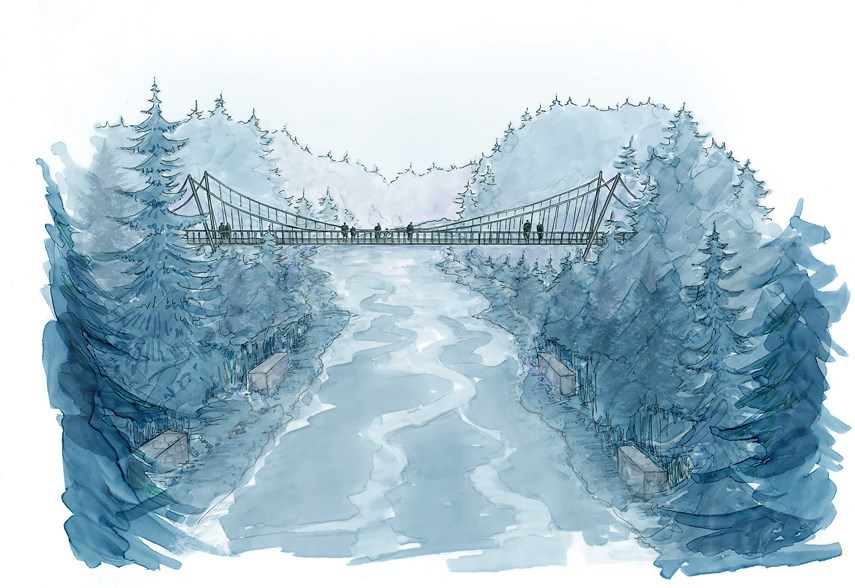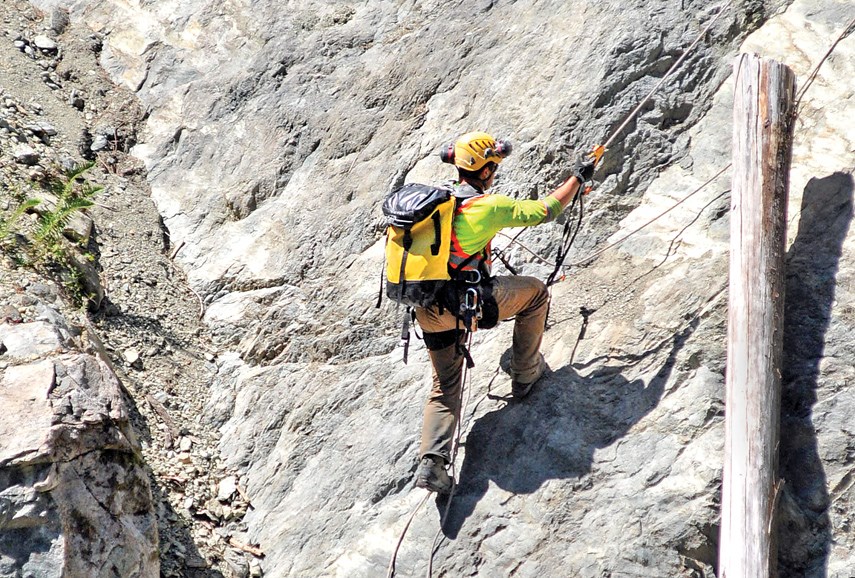The heroic mission to save the Seymour River is entering its second season.
The Seymour Salmonid Society hosted a ceremony July 5 at the site of the December 2014 rock slide that made the river impassible to spawning fish, marking the second year of attempts to undo the rock slide’s work.
For the rest of the summer, contractors will scale down to the bottom of the slide site and use pneumatic drills and hammers to plant low-velocity explosives deep into the boulders. Once detonated, the boulders break into pieces small enough that winter rains and spring runoff push them down to the river floor.
Salmonid society president Shaun Hollingsworth is hoping they can carve out a channel big enough to allow natural fish migration again within the next three years.
It’s still too early to say exactly how much of the original 50,000 cubic metres of granite that initially blocked fish passage has been flushed away into the canyon below but before-and-after images from 2016 and 2017 show significant improvement.
Hollingsworth, however, still sees a big job ahead.
“There’s a lot of work to do yet,” he said. “We’re taking rocks the size of vehicles and we’re making them the size of microwave ovens.”
Salmonid society volunteers will also be radio tagging returning fish this summer, just to see how far they can get on their own, although the current estimate is that it will take at least another year of rock breaking to restore the Seymour as fish habitat.
“I would hope they’ll make it by but I don’t think we’re going to track any fish beyond the slide. Not this year. But hopefully, with the work they do this summer and the work that
Mother Nature does during this winter, maybe this time next year we’ll be talking about a few fish making it past,” he said.
The good news is, Mother Nature was quite co-operative with heavy rains over the last year, with flow rates hitting 400 cubic metres per second, compared to the more lethargic six cubic metres per second the Seymour is running at now.
An earlier study found 50 fish – 85 per cent of tagged juvenile fish from above the slide site – were able to reach the estuary, but Hollingsworth said that’s probably thanks to higher than normal river levels.
For the first time in the Squamish Nation’s history, the river has been closed to members for subsistence fishing.
“But it is our sacred obligation as indigenous people with our brothers and sisters, the Tsleil-Waututh, to ensure that we’re protecting the stocks, we’re protecting the river for our grandchildren and those future generations we have not met yet,” said elected councillor Chris Lewis at the riverside ceremony.
Lewis praised the many partners in the project for coming together to mobilize a rescue effort for the coho, pink and chum salmon and steelhead trout that depend on the river.
“I don’t know of any other project that the Squamish are working on that has so many levels of government, local governments, community organizations and societies that have all come together and put our differences aside to say: ‘The best thing is to take care of the river so the river can take care of the fish,’” he said.
The Tsleil-Waututh and Squamish nations, the federal Department of Fisheries and Oceans, the B.C. Ministry of Forests, Lands and Natural Resource Operations, Metro Vancouver and the District of North Vancouver are all included in the project. It’s funded by government and grants from non-profits.

The start of the second phase of rock breaking comes just as Metro Vancouver, which has jurisdiction over the park land on either side of the river, is about to begin construction of a new bridge spanning the Seymour. The old Twin Bridges was washed out following the 2014 slide. Metro is now just waiting on final approval from the federal and provincial governments, as well as First Nations, to begin work on the $2.3-million Fisherman’s Bridge and trail connections.
“We’re making progress on the suspension bridge and should be going out to tender very shortly for that. It should take two to three months for construction so we should have it completed this year,” said Mike Mayers, superintendent of environmental management for Metro Vancouver.
Metro has opted for a rigid suspension bridge design, so unlike the Capilano and Lynn Creek suspension bridges, it won’t sway or move. The bridge will be 2.5 metres wide with railings high enough to accommodate people on bikes and horseback.



